Analysis of the Treaty of Waitangi: A History Essay
VerifiedAdded on 2023/04/22
|7
|2125
|365
Essay
AI Summary
This essay provides a comprehensive analysis of the Treaty of Waitangi, a foundational document in New Zealand's history signed in 1840. It delves into the treaty's creation, examining the context of British and Māori interactions and the need for establishing a government. The essay explores the key terms used in both the English and Māori versions of the treaty, such as 'kawanatanga' and 'rangatiratanga,' highlighting the challenges of translation and the differing understandings of these terms. It then presents the British and Māori interpretations of the treaty, revealing their contrasting perspectives on sovereignty, land ownership, and governance. The essay meticulously outlines the differences between these interpretations, particularly concerning the cession of sovereignty and the rights of Māori. Finally, it concludes by discussing the long-term consequences of these differing interpretations, including conflicts, land disputes, and the establishment of the Waitangi Tribunal to address grievances. The essay uses several sources to support the analysis and provide an in-depth understanding of this pivotal historical event.
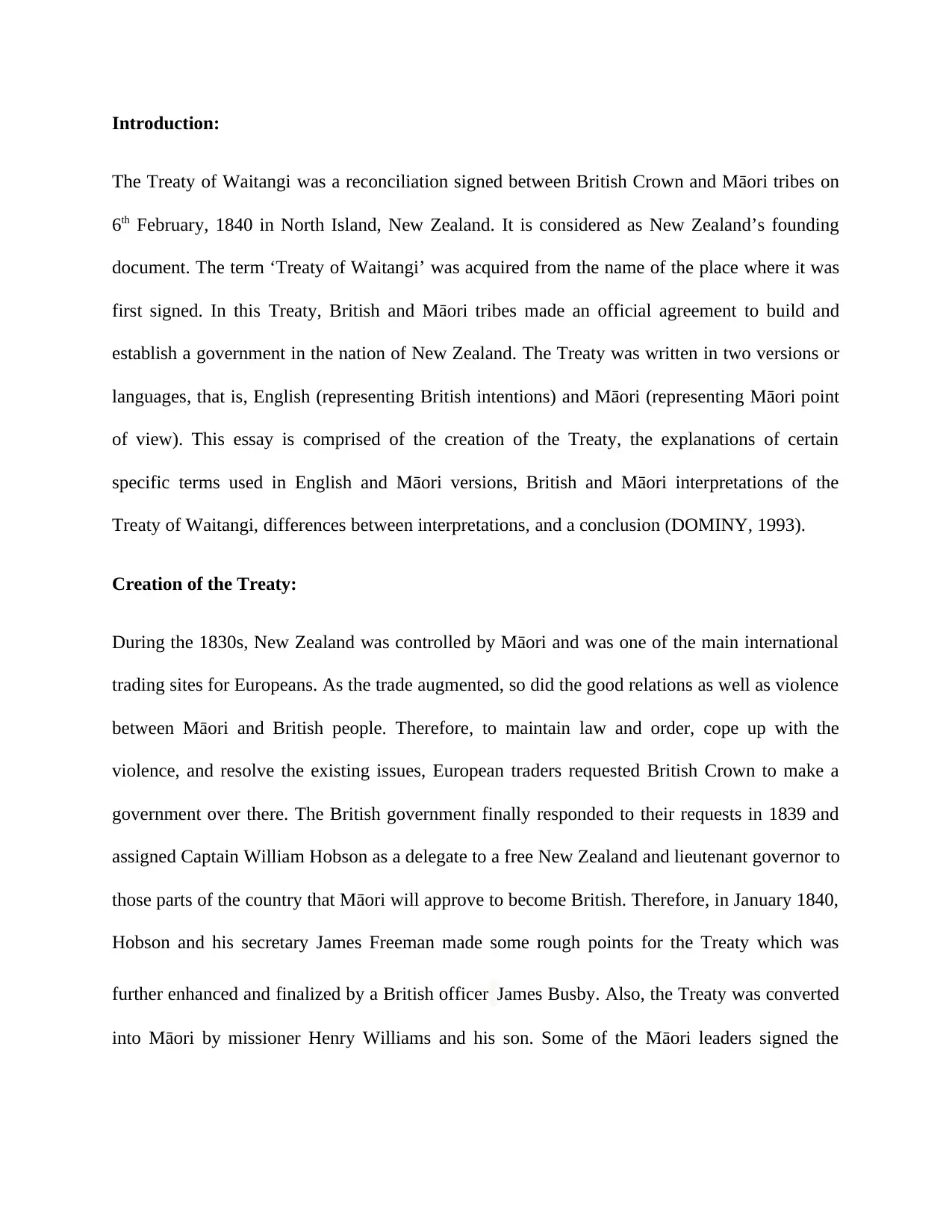
Introduction:
The Treaty of Waitangi was a reconciliation signed between British Crown and Māori tribes on
6th February, 1840 in North Island, New Zealand. It is considered as New Zealand’s founding
document. The term ‘Treaty of Waitangi’ was acquired from the name of the place where it was
first signed. In this Treaty, British and Māori tribes made an official agreement to build and
establish a government in the nation of New Zealand. The Treaty was written in two versions or
languages, that is, English (representing British intentions) and Māori (representing Māori point
of view). This essay is comprised of the creation of the Treaty, the explanations of certain
specific terms used in English and Māori versions, British and Māori interpretations of the
Treaty of Waitangi, differences between interpretations, and a conclusion (DOMINY, 1993).
Creation of the Treaty:
During the 1830s, New Zealand was controlled by Māori and was one of the main international
trading sites for Europeans. As the trade augmented, so did the good relations as well as violence
between Māori and British people. Therefore, to maintain law and order, cope up with the
violence, and resolve the existing issues, European traders requested British Crown to make a
government over there. The British government finally responded to their requests in 1839 and
assigned Captain William Hobson as a delegate to a free New Zealand and lieutenant governor to
those parts of the country that Māori will approve to become British. Therefore, in January 1840,
Hobson and his secretary James Freeman made some rough points for the Treaty which was
further enhanced and finalized by a British officer James Busby. Also, the Treaty was converted
into Māori by missioner Henry Williams and his son. Some of the Māori leaders signed the
The Treaty of Waitangi was a reconciliation signed between British Crown and Māori tribes on
6th February, 1840 in North Island, New Zealand. It is considered as New Zealand’s founding
document. The term ‘Treaty of Waitangi’ was acquired from the name of the place where it was
first signed. In this Treaty, British and Māori tribes made an official agreement to build and
establish a government in the nation of New Zealand. The Treaty was written in two versions or
languages, that is, English (representing British intentions) and Māori (representing Māori point
of view). This essay is comprised of the creation of the Treaty, the explanations of certain
specific terms used in English and Māori versions, British and Māori interpretations of the
Treaty of Waitangi, differences between interpretations, and a conclusion (DOMINY, 1993).
Creation of the Treaty:
During the 1830s, New Zealand was controlled by Māori and was one of the main international
trading sites for Europeans. As the trade augmented, so did the good relations as well as violence
between Māori and British people. Therefore, to maintain law and order, cope up with the
violence, and resolve the existing issues, European traders requested British Crown to make a
government over there. The British government finally responded to their requests in 1839 and
assigned Captain William Hobson as a delegate to a free New Zealand and lieutenant governor to
those parts of the country that Māori will approve to become British. Therefore, in January 1840,
Hobson and his secretary James Freeman made some rough points for the Treaty which was
further enhanced and finalized by a British officer James Busby. Also, the Treaty was converted
into Māori by missioner Henry Williams and his son. Some of the Māori leaders signed the
Paraphrase This Document
Need a fresh take? Get an instant paraphrase of this document with our AI Paraphraser
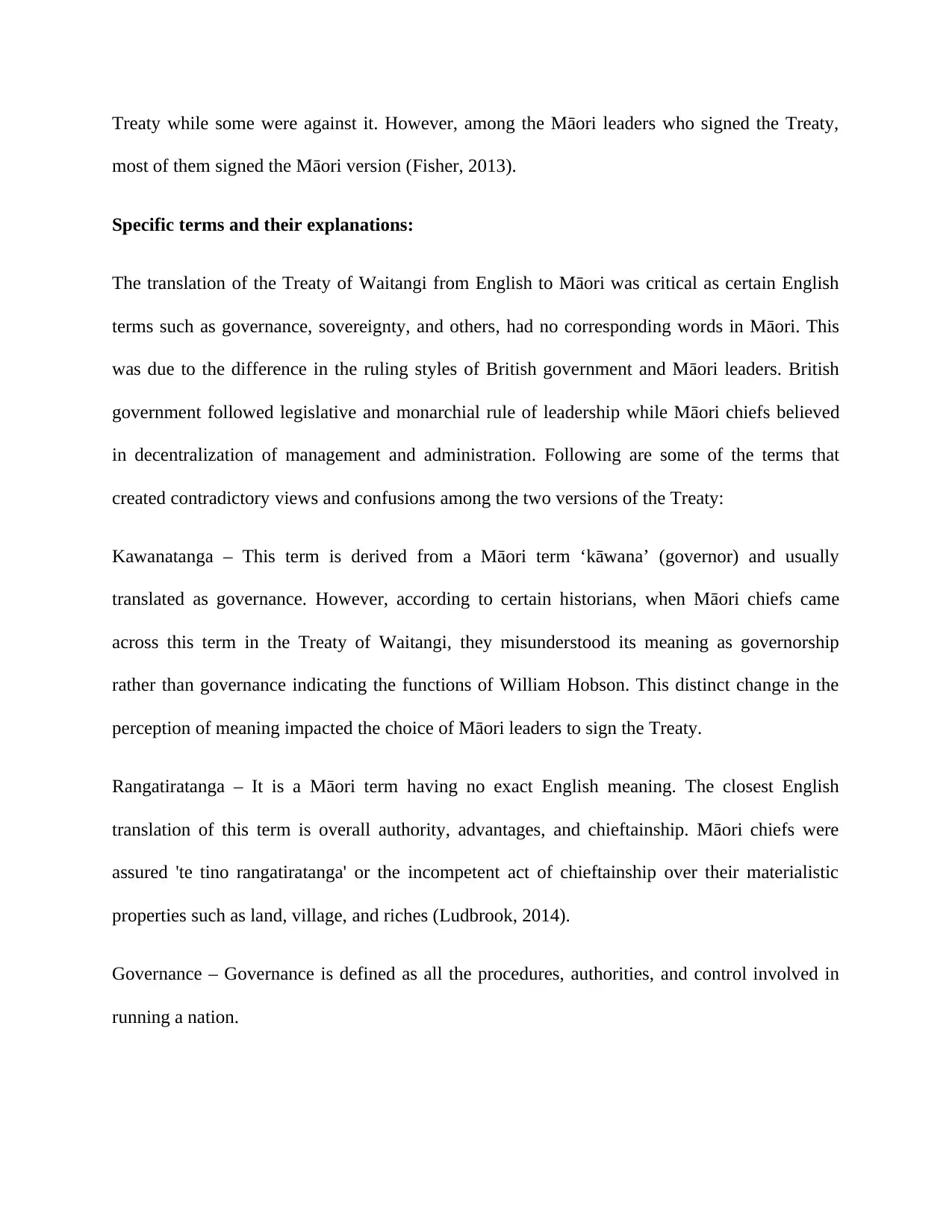
Treaty while some were against it. However, among the Māori leaders who signed the Treaty,
most of them signed the Māori version (Fisher, 2013).
Specific terms and their explanations:
The translation of the Treaty of Waitangi from English to Māori was critical as certain English
terms such as governance, sovereignty, and others, had no corresponding words in Māori. This
was due to the difference in the ruling styles of British government and Māori leaders. British
government followed legislative and monarchial rule of leadership while Māori chiefs believed
in decentralization of management and administration. Following are some of the terms that
created contradictory views and confusions among the two versions of the Treaty:
Kawanatanga – This term is derived from a Māori term ‘kāwana’ (governor) and usually
translated as governance. However, according to certain historians, when Māori chiefs came
across this term in the Treaty of Waitangi, they misunderstood its meaning as governorship
rather than governance indicating the functions of William Hobson. This distinct change in the
perception of meaning impacted the choice of Māori leaders to sign the Treaty.
Rangatiratanga – It is a Māori term having no exact English meaning. The closest English
translation of this term is overall authority, advantages, and chieftainship. Māori chiefs were
assured 'te tino rangatiratanga' or the incompetent act of chieftainship over their materialistic
properties such as land, village, and riches (Ludbrook, 2014).
Governance – Governance is defined as all the procedures, authorities, and control involved in
running a nation.
most of them signed the Māori version (Fisher, 2013).
Specific terms and their explanations:
The translation of the Treaty of Waitangi from English to Māori was critical as certain English
terms such as governance, sovereignty, and others, had no corresponding words in Māori. This
was due to the difference in the ruling styles of British government and Māori leaders. British
government followed legislative and monarchial rule of leadership while Māori chiefs believed
in decentralization of management and administration. Following are some of the terms that
created contradictory views and confusions among the two versions of the Treaty:
Kawanatanga – This term is derived from a Māori term ‘kāwana’ (governor) and usually
translated as governance. However, according to certain historians, when Māori chiefs came
across this term in the Treaty of Waitangi, they misunderstood its meaning as governorship
rather than governance indicating the functions of William Hobson. This distinct change in the
perception of meaning impacted the choice of Māori leaders to sign the Treaty.
Rangatiratanga – It is a Māori term having no exact English meaning. The closest English
translation of this term is overall authority, advantages, and chieftainship. Māori chiefs were
assured 'te tino rangatiratanga' or the incompetent act of chieftainship over their materialistic
properties such as land, village, and riches (Ludbrook, 2014).
Governance – Governance is defined as all the procedures, authorities, and control involved in
running a nation.
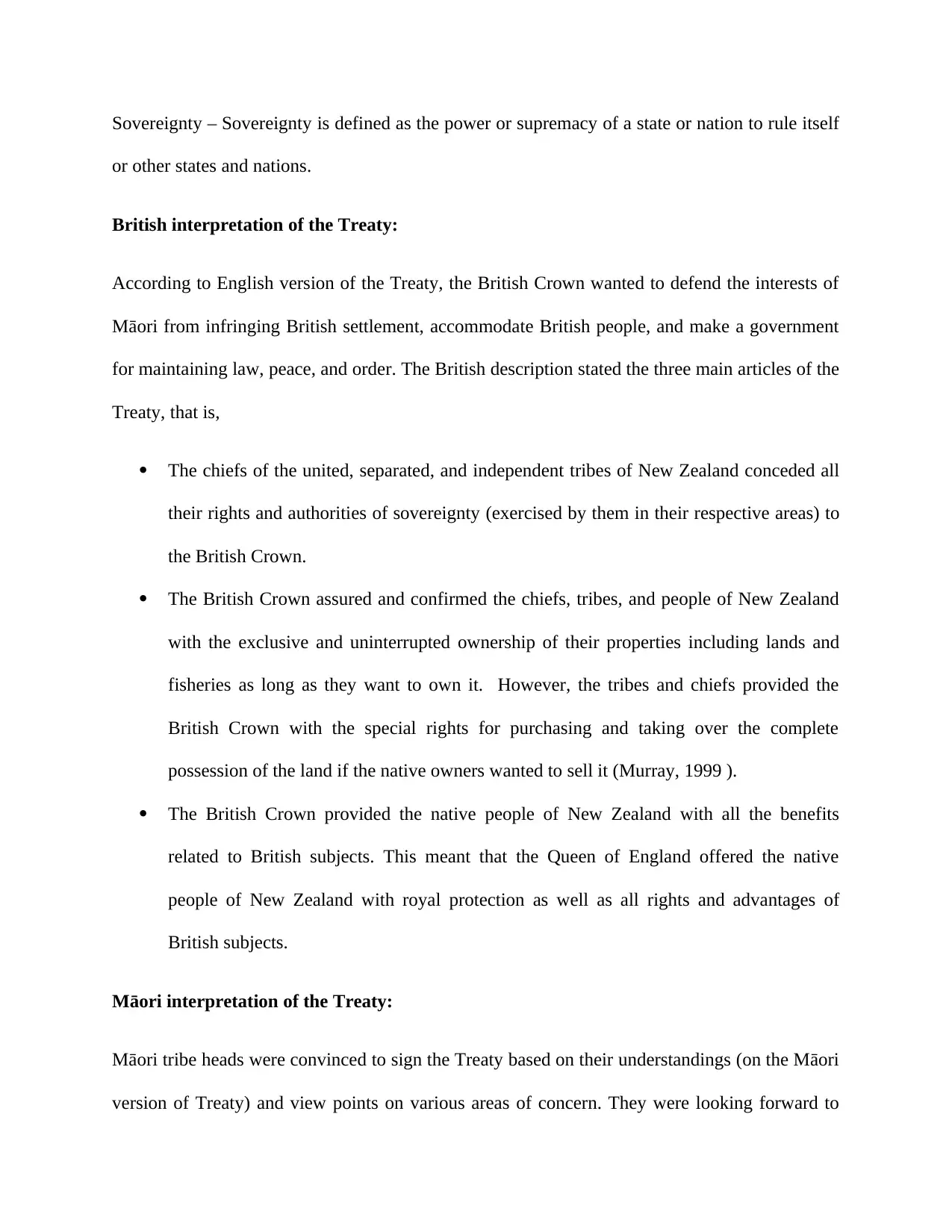
Sovereignty – Sovereignty is defined as the power or supremacy of a state or nation to rule itself
or other states and nations.
British interpretation of the Treaty:
According to English version of the Treaty, the British Crown wanted to defend the interests of
Māori from infringing British settlement, accommodate British people, and make a government
for maintaining law, peace, and order. The British description stated the three main articles of the
Treaty, that is,
The chiefs of the united, separated, and independent tribes of New Zealand conceded all
their rights and authorities of sovereignty (exercised by them in their respective areas) to
the British Crown.
The British Crown assured and confirmed the chiefs, tribes, and people of New Zealand
with the exclusive and uninterrupted ownership of their properties including lands and
fisheries as long as they want to own it. However, the tribes and chiefs provided the
British Crown with the special rights for purchasing and taking over the complete
possession of the land if the native owners wanted to sell it (Murray, 1999 ).
The British Crown provided the native people of New Zealand with all the benefits
related to British subjects. This meant that the Queen of England offered the native
people of New Zealand with royal protection as well as all rights and advantages of
British subjects.
Māori interpretation of the Treaty:
Māori tribe heads were convinced to sign the Treaty based on their understandings (on the Māori
version of Treaty) and view points on various areas of concern. They were looking forward to
or other states and nations.
British interpretation of the Treaty:
According to English version of the Treaty, the British Crown wanted to defend the interests of
Māori from infringing British settlement, accommodate British people, and make a government
for maintaining law, peace, and order. The British description stated the three main articles of the
Treaty, that is,
The chiefs of the united, separated, and independent tribes of New Zealand conceded all
their rights and authorities of sovereignty (exercised by them in their respective areas) to
the British Crown.
The British Crown assured and confirmed the chiefs, tribes, and people of New Zealand
with the exclusive and uninterrupted ownership of their properties including lands and
fisheries as long as they want to own it. However, the tribes and chiefs provided the
British Crown with the special rights for purchasing and taking over the complete
possession of the land if the native owners wanted to sell it (Murray, 1999 ).
The British Crown provided the native people of New Zealand with all the benefits
related to British subjects. This meant that the Queen of England offered the native
people of New Zealand with royal protection as well as all rights and advantages of
British subjects.
Māori interpretation of the Treaty:
Māori tribe heads were convinced to sign the Treaty based on their understandings (on the Māori
version of Treaty) and view points on various areas of concern. They were looking forward to
⊘ This is a preview!⊘
Do you want full access?
Subscribe today to unlock all pages.

Trusted by 1+ million students worldwide
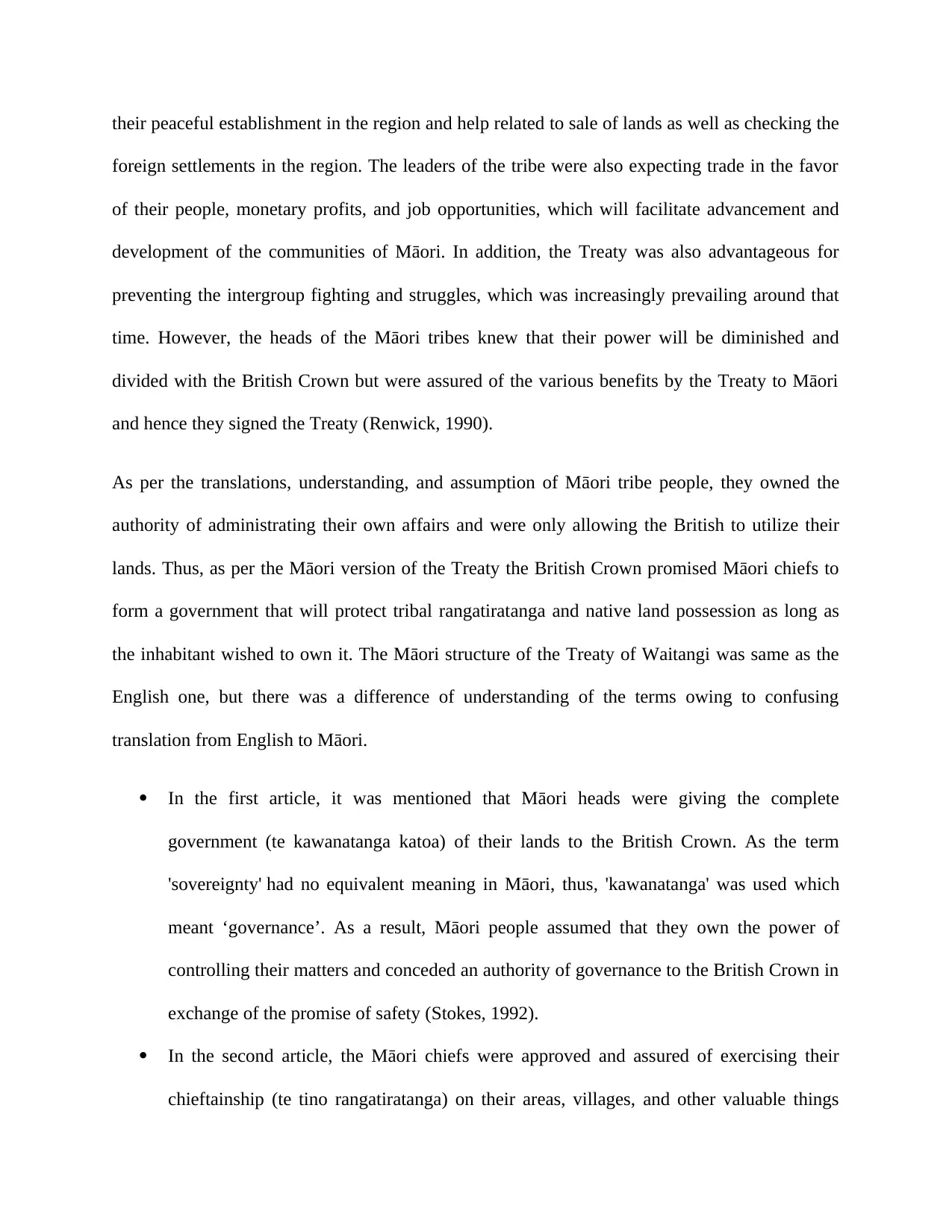
their peaceful establishment in the region and help related to sale of lands as well as checking the
foreign settlements in the region. The leaders of the tribe were also expecting trade in the favor
of their people, monetary profits, and job opportunities, which will facilitate advancement and
development of the communities of Māori. In addition, the Treaty was also advantageous for
preventing the intergroup fighting and struggles, which was increasingly prevailing around that
time. However, the heads of the Māori tribes knew that their power will be diminished and
divided with the British Crown but were assured of the various benefits by the Treaty to Māori
and hence they signed the Treaty (Renwick, 1990).
As per the translations, understanding, and assumption of Māori tribe people, they owned the
authority of administrating their own affairs and were only allowing the British to utilize their
lands. Thus, as per the Māori version of the Treaty the British Crown promised Māori chiefs to
form a government that will protect tribal rangatiratanga and native land possession as long as
the inhabitant wished to own it. The Māori structure of the Treaty of Waitangi was same as the
English one, but there was a difference of understanding of the terms owing to confusing
translation from English to Māori.
In the first article, it was mentioned that Māori heads were giving the complete
government (te kawanatanga katoa) of their lands to the British Crown. As the term
'sovereignty' had no equivalent meaning in Māori, thus, 'kawanatanga' was used which
meant ‘governance’. As a result, Māori people assumed that they own the power of
controlling their matters and conceded an authority of governance to the British Crown in
exchange of the promise of safety (Stokes, 1992).
In the second article, the Māori chiefs were approved and assured of exercising their
chieftainship (te tino rangatiratanga) on their areas, villages, and other valuable things
foreign settlements in the region. The leaders of the tribe were also expecting trade in the favor
of their people, monetary profits, and job opportunities, which will facilitate advancement and
development of the communities of Māori. In addition, the Treaty was also advantageous for
preventing the intergroup fighting and struggles, which was increasingly prevailing around that
time. However, the heads of the Māori tribes knew that their power will be diminished and
divided with the British Crown but were assured of the various benefits by the Treaty to Māori
and hence they signed the Treaty (Renwick, 1990).
As per the translations, understanding, and assumption of Māori tribe people, they owned the
authority of administrating their own affairs and were only allowing the British to utilize their
lands. Thus, as per the Māori version of the Treaty the British Crown promised Māori chiefs to
form a government that will protect tribal rangatiratanga and native land possession as long as
the inhabitant wished to own it. The Māori structure of the Treaty of Waitangi was same as the
English one, but there was a difference of understanding of the terms owing to confusing
translation from English to Māori.
In the first article, it was mentioned that Māori heads were giving the complete
government (te kawanatanga katoa) of their lands to the British Crown. As the term
'sovereignty' had no equivalent meaning in Māori, thus, 'kawanatanga' was used which
meant ‘governance’. As a result, Māori people assumed that they own the power of
controlling their matters and conceded an authority of governance to the British Crown in
exchange of the promise of safety (Stokes, 1992).
In the second article, the Māori chiefs were approved and assured of exercising their
chieftainship (te tino rangatiratanga) on their areas, villages, and other valuable things
Paraphrase This Document
Need a fresh take? Get an instant paraphrase of this document with our AI Paraphraser
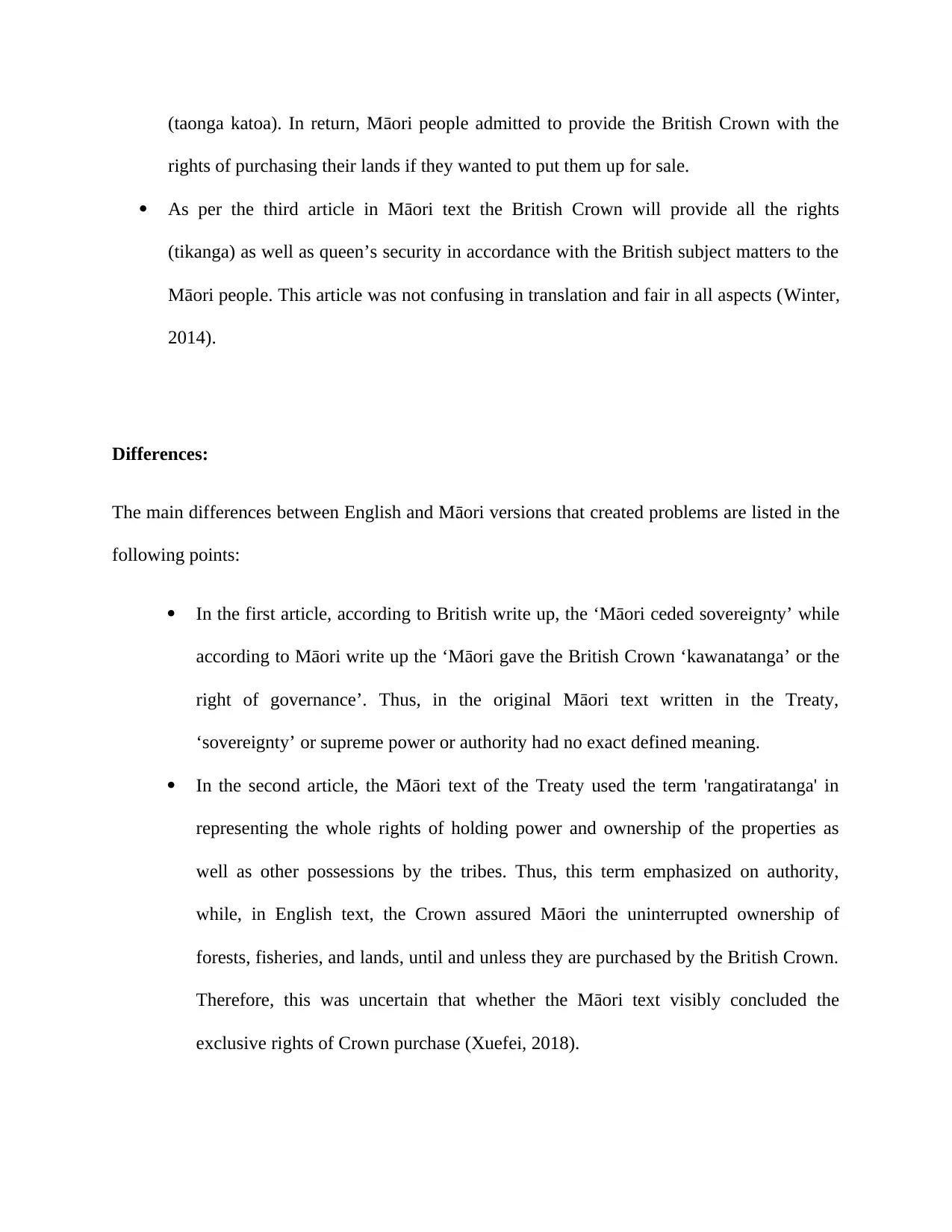
(taonga katoa). In return, Māori people admitted to provide the British Crown with the
rights of purchasing their lands if they wanted to put them up for sale.
As per the third article in Māori text the British Crown will provide all the rights
(tikanga) as well as queen’s security in accordance with the British subject matters to the
Māori people. This article was not confusing in translation and fair in all aspects (Winter,
2014).
Differences:
The main differences between English and Māori versions that created problems are listed in the
following points:
In the first article, according to British write up, the ‘Māori ceded sovereignty’ while
according to Māori write up the ‘Māori gave the British Crown ‘kawanatanga’ or the
right of governance’. Thus, in the original Māori text written in the Treaty,
‘sovereignty’ or supreme power or authority had no exact defined meaning.
In the second article, the Māori text of the Treaty used the term 'rangatiratanga' in
representing the whole rights of holding power and ownership of the properties as
well as other possessions by the tribes. Thus, this term emphasized on authority,
while, in English text, the Crown assured Māori the uninterrupted ownership of
forests, fisheries, and lands, until and unless they are purchased by the British Crown.
Therefore, this was uncertain that whether the Māori text visibly concluded the
exclusive rights of Crown purchase (Xuefei, 2018).
rights of purchasing their lands if they wanted to put them up for sale.
As per the third article in Māori text the British Crown will provide all the rights
(tikanga) as well as queen’s security in accordance with the British subject matters to the
Māori people. This article was not confusing in translation and fair in all aspects (Winter,
2014).
Differences:
The main differences between English and Māori versions that created problems are listed in the
following points:
In the first article, according to British write up, the ‘Māori ceded sovereignty’ while
according to Māori write up the ‘Māori gave the British Crown ‘kawanatanga’ or the
right of governance’. Thus, in the original Māori text written in the Treaty,
‘sovereignty’ or supreme power or authority had no exact defined meaning.
In the second article, the Māori text of the Treaty used the term 'rangatiratanga' in
representing the whole rights of holding power and ownership of the properties as
well as other possessions by the tribes. Thus, this term emphasized on authority,
while, in English text, the Crown assured Māori the uninterrupted ownership of
forests, fisheries, and lands, until and unless they are purchased by the British Crown.
Therefore, this was uncertain that whether the Māori text visibly concluded the
exclusive rights of Crown purchase (Xuefei, 2018).
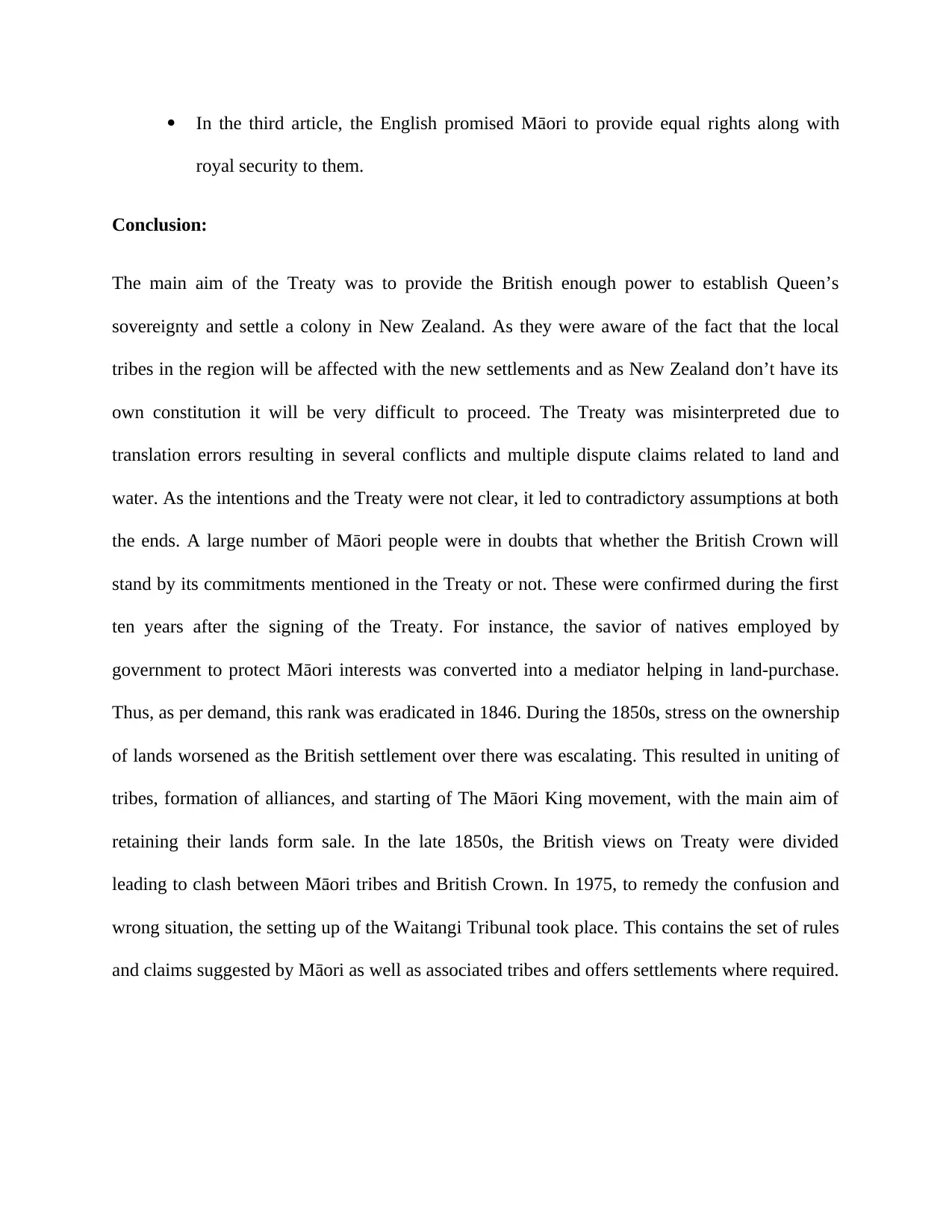
In the third article, the English promised Māori to provide equal rights along with
royal security to them.
Conclusion:
The main aim of the Treaty was to provide the British enough power to establish Queen’s
sovereignty and settle a colony in New Zealand. As they were aware of the fact that the local
tribes in the region will be affected with the new settlements and as New Zealand don’t have its
own constitution it will be very difficult to proceed. The Treaty was misinterpreted due to
translation errors resulting in several conflicts and multiple dispute claims related to land and
water. As the intentions and the Treaty were not clear, it led to contradictory assumptions at both
the ends. A large number of Māori people were in doubts that whether the British Crown will
stand by its commitments mentioned in the Treaty or not. These were confirmed during the first
ten years after the signing of the Treaty. For instance, the savior of natives employed by
government to protect Māori interests was converted into a mediator helping in land-purchase.
Thus, as per demand, this rank was eradicated in 1846. During the 1850s, stress on the ownership
of lands worsened as the British settlement over there was escalating. This resulted in uniting of
tribes, formation of alliances, and starting of The Māori King movement, with the main aim of
retaining their lands form sale. In the late 1850s, the British views on Treaty were divided
leading to clash between Māori tribes and British Crown. In 1975, to remedy the confusion and
wrong situation, the setting up of the Waitangi Tribunal took place. This contains the set of rules
and claims suggested by Māori as well as associated tribes and offers settlements where required.
royal security to them.
Conclusion:
The main aim of the Treaty was to provide the British enough power to establish Queen’s
sovereignty and settle a colony in New Zealand. As they were aware of the fact that the local
tribes in the region will be affected with the new settlements and as New Zealand don’t have its
own constitution it will be very difficult to proceed. The Treaty was misinterpreted due to
translation errors resulting in several conflicts and multiple dispute claims related to land and
water. As the intentions and the Treaty were not clear, it led to contradictory assumptions at both
the ends. A large number of Māori people were in doubts that whether the British Crown will
stand by its commitments mentioned in the Treaty or not. These were confirmed during the first
ten years after the signing of the Treaty. For instance, the savior of natives employed by
government to protect Māori interests was converted into a mediator helping in land-purchase.
Thus, as per demand, this rank was eradicated in 1846. During the 1850s, stress on the ownership
of lands worsened as the British settlement over there was escalating. This resulted in uniting of
tribes, formation of alliances, and starting of The Māori King movement, with the main aim of
retaining their lands form sale. In the late 1850s, the British views on Treaty were divided
leading to clash between Māori tribes and British Crown. In 1975, to remedy the confusion and
wrong situation, the setting up of the Waitangi Tribunal took place. This contains the set of rules
and claims suggested by Māori as well as associated tribes and offers settlements where required.
⊘ This is a preview!⊘
Do you want full access?
Subscribe today to unlock all pages.

Trusted by 1+ million students worldwide
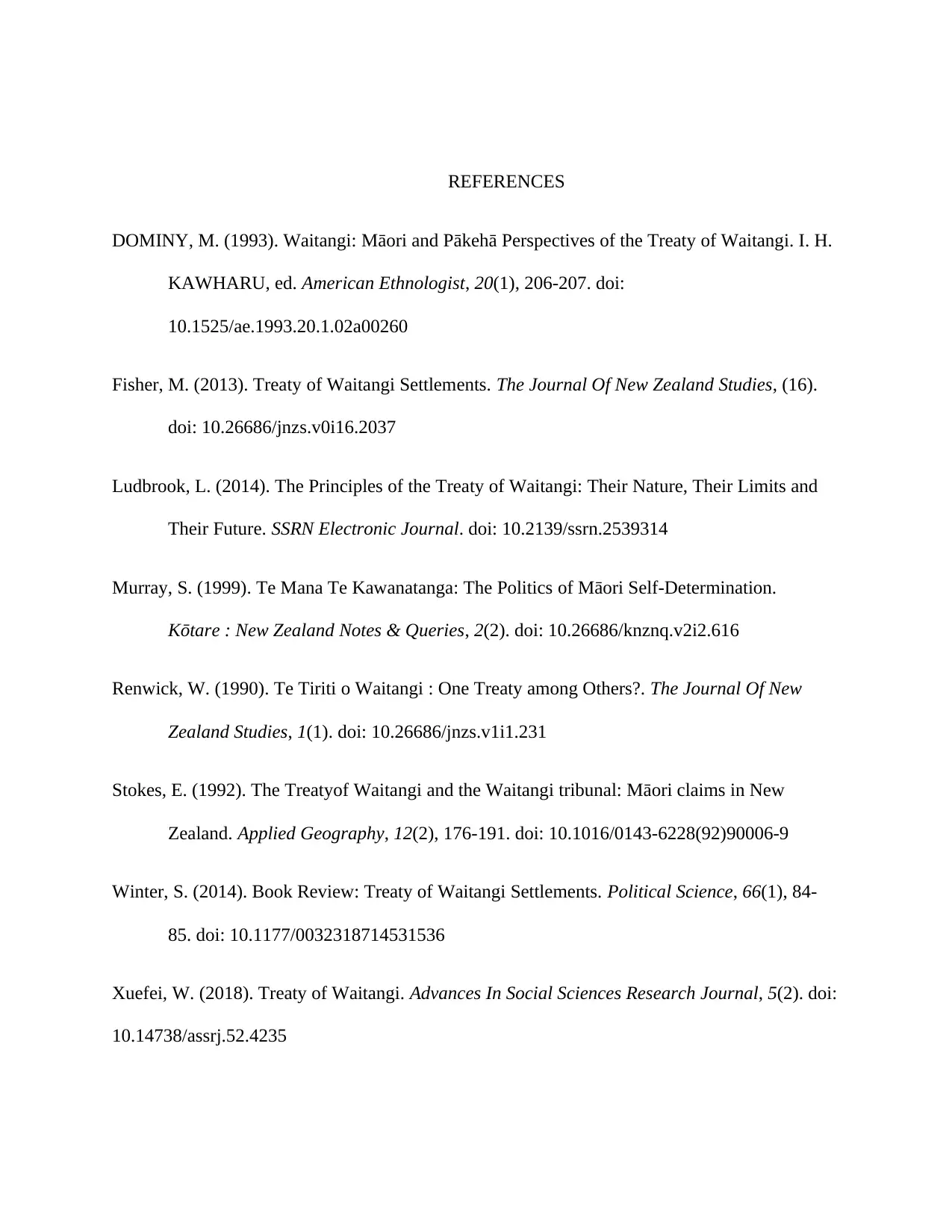
REFERENCES
DOMINY, M. (1993). Waitangi: Māori and Pākehā Perspectives of the Treaty of Waitangi. I. H.
KAWHARU, ed. American Ethnologist, 20(1), 206-207. doi:
10.1525/ae.1993.20.1.02a00260
Fisher, M. (2013). Treaty of Waitangi Settlements. The Journal Of New Zealand Studies, (16).
doi: 10.26686/jnzs.v0i16.2037
Ludbrook, L. (2014). The Principles of the Treaty of Waitangi: Their Nature, Their Limits and
Their Future. SSRN Electronic Journal. doi: 10.2139/ssrn.2539314
Murray, S. (1999). Te Mana Te Kawanatanga: The Politics of Māori Self-Determination.
Kōtare : New Zealand Notes & Queries, 2(2). doi: 10.26686/knznq.v2i2.616
Renwick, W. (1990). Te Tiriti o Waitangi : One Treaty among Others?. The Journal Of New
Zealand Studies, 1(1). doi: 10.26686/jnzs.v1i1.231
Stokes, E. (1992). The Treatyof Waitangi and the Waitangi tribunal: Māori claims in New
Zealand. Applied Geography, 12(2), 176-191. doi: 10.1016/0143-6228(92)90006-9
Winter, S. (2014). Book Review: Treaty of Waitangi Settlements. Political Science, 66(1), 84-
85. doi: 10.1177/0032318714531536
Xuefei, W. (2018). Treaty of Waitangi. Advances In Social Sciences Research Journal, 5(2). doi:
10.14738/assrj.52.4235
DOMINY, M. (1993). Waitangi: Māori and Pākehā Perspectives of the Treaty of Waitangi. I. H.
KAWHARU, ed. American Ethnologist, 20(1), 206-207. doi:
10.1525/ae.1993.20.1.02a00260
Fisher, M. (2013). Treaty of Waitangi Settlements. The Journal Of New Zealand Studies, (16).
doi: 10.26686/jnzs.v0i16.2037
Ludbrook, L. (2014). The Principles of the Treaty of Waitangi: Their Nature, Their Limits and
Their Future. SSRN Electronic Journal. doi: 10.2139/ssrn.2539314
Murray, S. (1999). Te Mana Te Kawanatanga: The Politics of Māori Self-Determination.
Kōtare : New Zealand Notes & Queries, 2(2). doi: 10.26686/knznq.v2i2.616
Renwick, W. (1990). Te Tiriti o Waitangi : One Treaty among Others?. The Journal Of New
Zealand Studies, 1(1). doi: 10.26686/jnzs.v1i1.231
Stokes, E. (1992). The Treatyof Waitangi and the Waitangi tribunal: Māori claims in New
Zealand. Applied Geography, 12(2), 176-191. doi: 10.1016/0143-6228(92)90006-9
Winter, S. (2014). Book Review: Treaty of Waitangi Settlements. Political Science, 66(1), 84-
85. doi: 10.1177/0032318714531536
Xuefei, W. (2018). Treaty of Waitangi. Advances In Social Sciences Research Journal, 5(2). doi:
10.14738/assrj.52.4235
1 out of 7
Related Documents
Your All-in-One AI-Powered Toolkit for Academic Success.
+13062052269
info@desklib.com
Available 24*7 on WhatsApp / Email
![[object Object]](/_next/static/media/star-bottom.7253800d.svg)
Unlock your academic potential
Copyright © 2020–2025 A2Z Services. All Rights Reserved. Developed and managed by ZUCOL.





